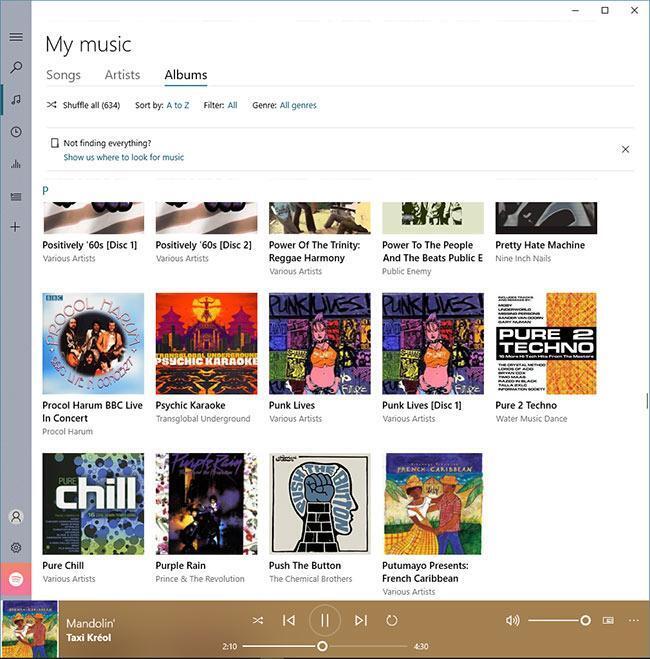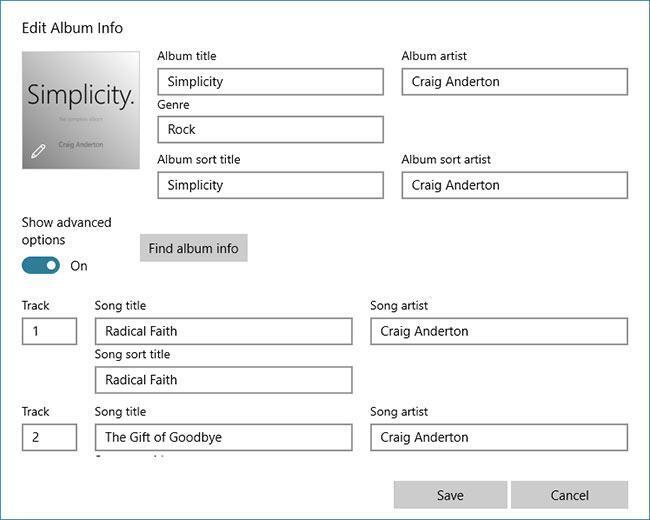Player Show Album Art Cool Windows Music Player Shows Album Blur Back

If yous bought a Cosmos Station lately, so it has Windows x installed — and office of the operating organization is the Groove Music player. Although originally designed for Microsoft's sick-blighted streaming service, it's really a very capable music player with 1 glaring flaw: there's no real documentation, so the net is filled with threads (more often than not unanswered) like "Groove Music not updating library," "don't know how to update Groove Music in Windows x," "can't effigy out how to reset Groove Music," "how to fix Unknown Album problem," "how to add together custom artwork," and the like — the list goes on.
I too ran into these problems, so I checked out other music players and, unfortunately, found them lacking. iTunes doesn't recognize nearly as many formats, and the other free players I tried were either more complicated than I wanted, or as well unproblematic. Then, being stubborn, I kept experimenting with Groove Music until I found out that not only tin information technology carry well, but it's really quite cool. Then whether y'all want music on your desktop while you lot piece of work or a USB stick to load in your car's audio organization, hopefully the post-obit volition serve as the missing documentation on how to brand Groove Music a productive fellow member of your calculator-based society (fig. 1).

Figure ane: Groove Music with anthology art.
File Formats
Groove Music can read MP3, FLAC, AAC, M4A, WAV, WMA, AC3, 3GP, 3G2, and AMR files as well every bit some more esoteric ones (simply not AIF). Neither Groove Music (nor iTunes) tin read CDA files straight from a CD; they demand to exist ripped to one of the to a higher place formats first. For comparing, iTunes supports MP3, AAC, AIF, Apple tree Lossless, Audible AA, WAV, and iTunes-purchased M4A and M4P files. (At least for now, you'll need to convert FLAC files to Apple Lossless format.)
Formatting Memory
I keep music files on a USB stick so the music doesn't have up internal storage, and it's transportable from computer to figurer. Format the stick as NTFS, then right-click on information technology and choose "Allow files on this bulldoze to accept contents indexed in addition to file properties." Request Groove Music to organize files on a USB stick formatted as FAT32 (recognized by only nearly everything on the planet, including car stereo systems) is problematic. Even so, for automobile audio systems and other portable players, you can format a USB stick every bit FAT32 and copy over the files from your "master," NTFS-formatted music library.
Fixing "Unknown Album" and "Unknown Artist"
This is one of the most frustrating aspects of Groove Music. Any music without an album tag will end upwardly in an album called "Unknown Anthology." Click on it to see a listing of the music Groove Music can't sort. Right-click on a title and cull Edit Info to see the music's full name. All the same, I recommend not editing the info — if previously unknown, the music will disappear until you reset the library. I prefer to bring tagless music into a tagging program (like MP3Tag, Tigo Tago, or TagScanner). The VLC Media Player from videolan.org works corking; elevate the music you want to tag into it, and choose Tools > Media Information. Enter the album, creative person info, and other metadata, so click on Save Metadata. The music will be removed from Groove Music's Unknown Anthology and appear with your other songs and albums (with by and large no reset required).
When to Use Edit Info
If an album is known and its data is part of the database, yous can tweak titles, song social club, artist, and artwork (encounter next) without having to reset the database. Whatever changes will be made immediately. 1 cool feature is that y'all can modify the track club past changing the Track number, then if you're into making a collection or desire to try different rails orders on your next album, it's easy to do.
Adding Album Artwork
Groove Music can detect album artwork if you right-click on the album, choose Edit Info, so click on Find Album Info (make certain Prove Advanced Options is on). If no artwork is available, check Amazon or other sites that sell CDs. Download the art, and save it (fig. ii).

Figure 2: Custom album artwork has been added in the Edit Anthology Info.
In the album'southward Edit Info window, click on the default circle-in-square art, which opens a path to navigate to the desired artwork. Click on Open. Afterwards the artwork appears, click on Save. Groove Music can calibration art, but I haven't tested its limits — I resize to 150 x 150 pixels.
Resetting the Database
If you make changes and they don't evidence upwards in Groove Music, it may be time for a database reset. This is a noninvasive operation, so don't be afraid to do information technology. To reset the database, close Groove Music. And so navigate to:
C:\Users\[your user name]\AppData\Local\Packages\Microsoft.ZuneMusic_16-digit combination of random letters and numbers\LocalState\Database\16-digit combination of random messages and numbers
Delete the file within the Database folder that's named with the incomprehensible mess of messages and numbers, then open Groove Music. It will take a while to add all the music if yous have a large collection, just your library volition be upwards to engagement when the functioning completes.
Y'all can also reset past choosing Settings > Apps & Features > Groove Music > Avant-garde Options and then clicking on the Reset button, but this reinstalls the app and reverts to default settings, so you'll lose the app data. Use this option if Groove Music becomes corrupted or is completely unresponsive (but make sure your audio subsystem is in working condition — for example, Groove Music won't load if information technology's assigned to an external sound interface that's turned off).
Uninstalling Groove Music
After reading this, hopefully you realize that Groove Music tin can practice what y'all want. Simply if you desire to uninstall, y'all can do and then with Windows Powershell. (The standard Programs & Features uninstall choice tin can't uninstall it.)
- Brand certain Groove Music isn't open.
- Blazon Powershell in the taskbar's Search field. When Windows Powershell appears in the start menu, right-click on information technology and cull Run as Administrator.
- Click Yeah when it asks most making changes.
- At the command prompt, blazon Get-AppxPackage | select name, PackageFullName
- You'll see a listing of all packages. Locate the line that starts with Microsoft.ZuneMusic, and then copy the entire line (fig. 3) — it will wait something similar Microsoft.ZuneMusic_10.18081.11121.0_x64__16-digit combination of random letters and numbers.

Figure three: Copy the highlighted line prior to uninstalling.
- At the command prompt, type Go-AppxPackage PackageFullName | remove-AppxPackage. Note that PackageFullName should be what you copied in step 5.
- Hitting enter, and Groove Music will vanish.
Source: https://www.sweetwater.com/insync/make-windows-10-groove-music-work-way-want/
0 Response to "Player Show Album Art Cool Windows Music Player Shows Album Blur Back"
Post a Comment